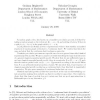Free Online Productivity Tools
i2Speak
i2Symbol
i2OCR
iTex2Img
iWeb2Print
iWeb2Shot
i2Type
iPdf2Split
iPdf2Merge
i2Bopomofo
i2Arabic
i2Style
i2Image
i2PDF
iLatex2Rtf
Sci2ools
RSA
2010
2010
Continuum limits for classical sequential growth models
A random graph order, also known as a transitive percolation process, is defined by taking a random graph on the vertex set {0, . . . , n − 1}, and putting i below j if there is a path i = i1 · · · ik = j in the graph with i1 < · · · < ik. In [15], Rideout and Sorkin provide computational evidence that suitably normalised sequences of random graph orders have a “continuum limit”. We confirm that this is the case, and show that the continuum limit is always a semiorder. Transitive percolation processes are a special case of a more general class called classical sequential growth models. We give a number of results describing the large-scale structure of a general classical sequential growth model. We show that for any sufficiently large n, and any classical sequential growth model, there is a semiorder S on {0, . . . , n − 1} such that the random partial order on {0, . . . , n − 1} generated according to the model differs from S on an arbitrarily small proporti...
| Added | 30 Jan 2011 |
| Updated | 30 Jan 2011 |
| Type | Journal |
| Year | 2010 |
| Where | RSA |
| Authors | Graham Brightwell, Nicholas Georgiou |
Comments (0)

